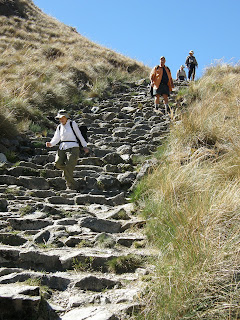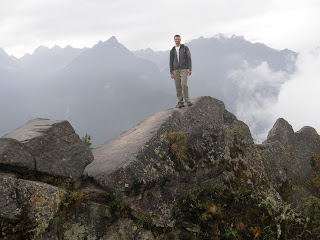I found the first day of our trip to be extremely entertaining, despite the fact that we only rafted for about 1.5 hours. The six of us plus a designated driver packed into a medium sized van with the remainder of the inside and top of the van maxed out with deflated boats and gear for 6 days. Up until this point, we had not been off of what I would call the "tourist trail'. We drove for a little over 3 hours from Cusco, and before we even left the city we were seeing Peruvians engaged in common activities, immersed in their own culture without the overwhelming influence of tourism. I was excited to see Peruvian culture, and things only got better the further we drove. After about 2 hours we stopped in a town that was having a huge festival, complete with ancient ritualistic dances and music. And the best part was that they weren't doing it just so tourists would throw them a couple dollars (we were the only two tourists in the town, and they weren't expecting us)!
After losing several thousand vertical feet while descending into the small village of Naywa in the bottom of the Apúrimac River Valley (this bit of driving was the scariest part of the trip), we got out of the van and spent the next couple of hours hauling our gear from the town to the river (about a 20 minute walk each way). The Naywa locals, including the 60-year-old women, put us to shame as they carried about three 60-pound loads each. One of the men, who weighed about a 120 pounds, made three trips in which he managed to carry two 100 pound dry boxes and the 110 pound raft. I think Dad and I combined to carry a kayak, a pump, and a small backpack.

First camp site
The guide, Boris, was a good boater, but he seemed to lack organizational skills. There was a lot of dirking around while they tried to figure out how to load their boats each morning. The best episode of dirking occurred in the first class 5 rapid. The video below shows the safety boater's run, which was very smooth. As the guide made us walk around the rapid, he was tasked with getting the raft down by himself.
He shot for the middle slot, same as the kayaker, only to find that it wasn't wide enough. He ended up getting out of the boat and pushing the raft over from the barely covered rock just to the right of the boat in the photo below.

After pushing the raft over while holding onto the bow line, the boat proceeded to go downstream with more force than Boris could handle. Had his foot not been wrapped around the tail end of the bow line, I'm sure he would have just let it go and let the kayaker run it down. As it was, letting go was not an option. What happened next was such a cluster I can't describe it. Suffice it to say that he eventually got his foot untangled, let the raft go, and escaped with only rope burns on his hands.
Over the course of the trip, there were 6 5th class rapids and the guide made us walk around all but one of them. I thought this was bull s@*! and basically told Boris so, but he wouldn't let us paddle them anyway. I've done enough rafting with Keith to know when something is runnable, and all of them were runnable in my opinion.
On the fourth day we stopped by a side creek and hiked up it a short ways to a waterfall. This reminded both Dad and me of the side hikes in the Grand Canyon.


Classic example of a Peruvian road switchbacking down a steep face
Early on the morning of the 5th day, two British clients joined our group as we had come to the first road crossing since we started. They did surprisingly well over the next 2 days, considering that neither of them had ever rafted before and the final two days were non-stop class 3 and 4 rapids.

When we started the trip, the rock was mostly black granite and conglomerate. About half way through the trip it changed to this white granite, coinciding with a steepening of the canyon walls.

This class 5 by the name of Toothache looks really fun. Unfortunately, the guides were once again selfish and made us walk around. The rock sticking up to the left of the raft in the photo is the tooth.
Everything went very well and was basically too safe. We remained healthy and uninjured all the way to the take out. Upon carrying the raft up the hill at the take out, I had a vicious encounter with a mean stock of bamboo. I came out victorious after breaking the bamboo stock clean in half, and all it managed to do was slice the top of my foot open.
After setting the raft down I took a look at the top of my foot, and immediately knew something was wrong when I noticed that I could see 1/4 inch into my foot. Luckily we had beer and Dad brought his 1st aid kit. A week later, after returning to Boulder, I decided that my foot was hurting more than it should and went to see a doctor. The doctor opened up the wound, pulled an inch of bamboo 'debris' out of the top of my foot, and sent me home. The wound is now healing well, and the nerve damage seems to get better every day.














































